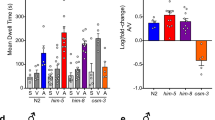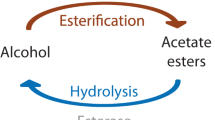Abstract
The antennae of male silk moths are extremely sensitive to the female sex pheromone such that a male moth can find a female up to 4.5 km away1. This remarkable sensitivity is due to both the morphological and biochemical design of these antennae. Along the branches of the plumose antennae are the sensilla trichodea, each consisting of a hollow cuticular hair containing two unbranched dendrites bathed in a fluid, the receptor lymph2,3. The dendrites and receptor lymph are isolated from the haemolymph by a barrier of epidermal cells which secreted the cuticular hair4–6. Pheromone molecules are thought to diffuse down 100 Å-wide pore tubules through the cuticular wall and across the receptor lymph space to receptors located in the dendritic membrane6,7. To prevent the accumulation of residual stimulant and hence sensory adaptation, the pheromone molecules are subsequently inactivated in an apparent two-step process of rapid ‘early inactivation’ followed by much slower enzymatic degradation8,9. The biochemistry involved in this sequence of events is largely unknown. We report here the identification of three proteins which interact with the pheromone of the wild silk moth Antheraea polyphemus: a pheromone-binding protein and a pheromone-degrading esterase, both uniquely located in the pheromone-sensitive sensilla; and a second esterase common to all cuticular tissues except the sensilla.
This is a preview of subscription content, access via your institution
Access options
Subscribe to this journal
Receive 51 print issues and online access
$199.00 per year
only $3.90 per issue
Buy this article
- Purchase on Springer Link
- Instant access to full article PDF
Prices may be subject to local taxes which are calculated during checkout
Similar content being viewed by others
References
Rau, P. & Rau, N. Trans. Acad. Sci. St Louis 26, 83–221 (1929).
Boeckh, J., Kaissling, K. -E. & Schneider, D. Zool. Jahrb. Abt. Anat. 78, 559–584 (1960).
Kaissling, K. -E. & Thorson, J. in Receptors for Neurotransmitters, Hormones and Pheromones in Insects (eds Satelle, D. B., Hall, L. M. & Hildebrand, J. G.) 261–282 (Elsevier, Amsterdam, 1980).
Steinbrecht, R. A. & Kasang, G. in Int. Symp. Olfaction and Taste Vol. 4 (ed. Schneider, D.) 193–199 (Wiss, Stuttgart, 1972).
Steinbrecht, R. A. & Muller, B. Z. Zellforsch. mikrosk. Anat. 117, 570–575 (1971).
Steinbrecht, R. A. Z. Zellforsch. mikrosk. Anat. 139, 533–565 (1973).
Steinbrecht, R. A. Tissue & Cell 12, 73–100 (1980).
Kaissling, K. E. in Biochemistry of Sensory Functions (ed. Jaenicke, L.) 243–273 (Springer, Heidelberg, 1974).
Kaissling, K. -E. in Int. Symp. Olfaction and Taste Vol. 4 (ed. Schneider, D.) 207–213 (Wiss, Stuttgart, 1972).
Kochansky, J. et al. J. Insect Physiol. 21, 1977–1983 (1975).
Weber, K. & Osborn, M. J. biol. Chem. 244, 4406–4412 (1969).
Davies, G. & Stark, G. Proc. natn. Acad. Sci. U.S.A. 66, 651–656 (1970).
Kasang, G. in Gustation and Olfaction (eds Ohloff, G. & Thomas, A. F.) 245–250 (Academic, New York, 1971).
Vogt, R. G. & Riddiford, L. M. in Regulation of Insect Development and Behaviour (eds Sehnal, F., Zabza, A., Menn, J. J. & Cymborowski, B.) 955–967 (Polytechnical University of Wroclaw Press, Wroclaw, 1981).
Kramer, E. in Int. Symp. Olfaction and Taste Vol. 5 (eds Denton, D. A. & Coghlan, J. P.) 329–335 (Academic, New York, 1975).
Kennedy, J. S., Ludlow, A. R. & Sanders, C. J. Nature 288, 475–477 (1980).
Laemmli, U. K. Nature 227, 680–685 (1970).
Ames, G. F. -L. J. biol. Chem. 249, 634–644 (1974).
Shaw, C. R. & Prasad, R. Biochem. Genet. 4, 297–320 (1970).
Chamberlain, J. P. Analyt. Biochem. 98, 132–135 (1979).
Ruchel, R. J. Histochem. Cytochem. 24, 773–791 (1976).
Author information
Authors and Affiliations
Rights and permissions
About this article
Cite this article
Vogt, R., Riddiford, L. Pheromone binding and inactivation by moth antennae. Nature 293, 161–163 (1981). https://doi.org/10.1038/293161a0
Received:
Accepted:
Issue Date:
DOI: https://doi.org/10.1038/293161a0
This article is cited by
-
Odorant-Binding and Chemosensory Proteins in Fig Wasps: Evolutionary Insights From Comparative Studies
Journal of Molecular Evolution (2024)
-
Antennal transcriptome analysis of Psyttalia incisi (silvestri) (Hymenoptera: Braconidae): identification and tissue expression profiling of candidate odorant-binding protein genes
Molecular Biology Reports (2024)
-
Genome-wide identification and characterization of the chemosensory relative protein genes in Rhus gall aphid Schlechtendalia chinensis
BMC Genomics (2023)
-
The antennal transcriptome analysis and characterizations of odorant-binding proteins in Megachile saussurei (Hymenoptera, Megachilidae)
BMC Genomics (2023)
-
iOBPdb A Database for Experimentally Determined Functional Characterization of Insect Odorant Binding Proteins
Scientific Data (2023)
Comments
By submitting a comment you agree to abide by our Terms and Community Guidelines. If you find something abusive or that does not comply with our terms or guidelines please flag it as inappropriate.



